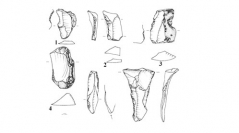

 Comptes Rendus Palevol
7 (4) - Pages 249-258
Comptes Rendus Palevol
7 (4) - Pages 249-258Technologic analyses of Neolithic obsidian assemblages are quite rare in Sardinia, like in the wider Western Mediterranean. Such an approach is presented here in conjunction with a visual/instrumental provenance study for the Rio Saboccu Early Neolithic (EN) site, which yielded more than 1000 obsidian artefacts. It is shown that this mostly expedient industry was realized from a non-opportunistic exploitation of the four obsidian types of the nearby Monte Arci (Sardinia) volcanic massif. The choice of the raw materials was chiefly guided by their intrinsic knapping qualities and in function of the maximum size of the expected final products; hence some selection in the (primary and/or secondary) sources exploited. The obsidian industries of EN sites from the northern Tyrrhenian area present clearly some affinities with that of Rio Saboccu and of other EN Sardinian sites, mainly those located in its vicinity. This suggests a regional influence of the EN communities settled in the proximity of the Monte Arci.
Obsidian provenance, PIXE, SEM-EDS, Chaînes opératoires, Early Neolithic, Rio Saboccu, Sardinia